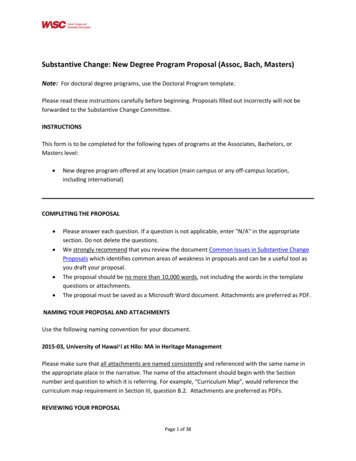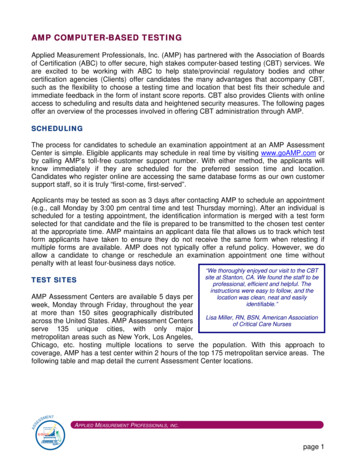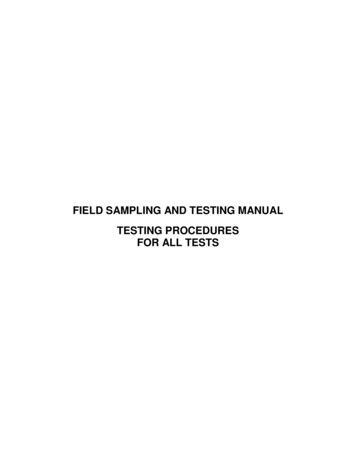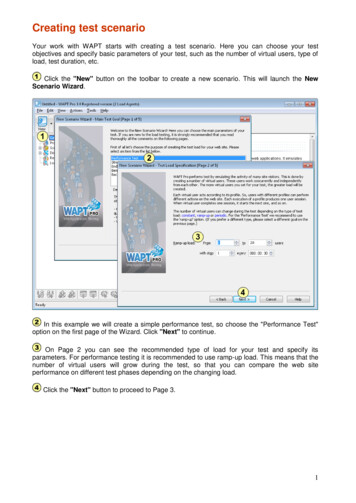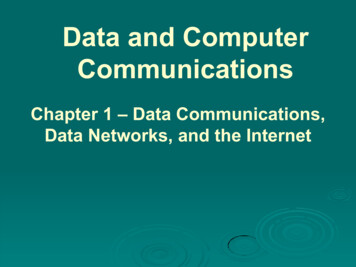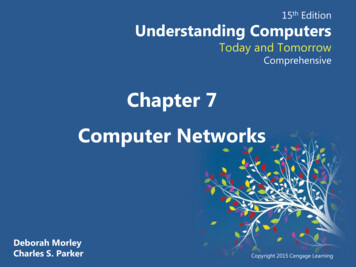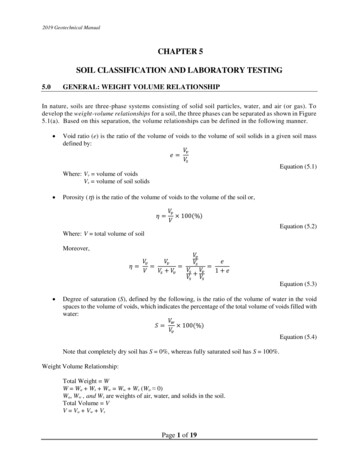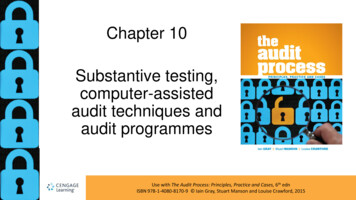
Transcription
Chapter 10Substantive testing,computer-assistedaudit techniques andaudit programmesUse with The Audit Process: Principles, Practice and Cases, 6th ednISBN 978-1-4080-8170-9 Iain Gray, Stuart Manson and Louise Crawford, 2015
Learning objectives To describe the substantive procedures an auditor would perform to prove thatrecorded transactions and figures are genuine, accurate and complete. To explain the purpose of selecting a sample when performing substantiveprocedures. To draft suitable conclusions after substantive procedures have beenperformed. To draft a management letter, containing recommendations on internal controland other matters of interest to management and others charged withgovernance, and to the auditor.Use with The Audit Process: Principles, Practice and Cases, 6th ednISBN 978-1-4080-8170-9 Iain Gray, Stuart Manson and Louise Crawford, 20152
Substantive testing of transactions, balances,disclosures Auditors use substantive procedures to test if transactions – processed andcontrolled by accounting and control systems – are genuine, accurate andcomplete. Reminder of definitions:a) Substantive procedure – an audit procedure designed to detect materialmisstatements at the assertion level. Substantive procedures comprise:i. Tests of details (of classes of transactions, account balances, and disclosures); andii. Substantive analytical procedures.b) Test of controls – an audit procedure designed to evaluate the operatingeffectiveness of controls in preventing, or detecting and correcting, materialmisstatements at the assertion level.Use with The Audit Process: Principles, Practice and Cases, 6th ednISBN 978-1-4080-8170-9 Iain Gray, Stuart Manson and Louise Crawford, 20153
Substantive ‘tests of detail’ and ‘substantive analytical procedures’ Tests of detail: detailed testing of transactions and balances. Audit objective: toensure, e.g., turnover includes all despatches of goods. Substantive analytical procedures not concerned with detail. If analytical reviewresults are as expected, auditor might accept entity’s controls to ensure, e.g., salesare genuine, accurate and complete. Auditors restrict substantive tests to analytical procedures if satisfied companycontrols are strong. If deemed weak, solely analytical procedures not enough. Two reasons why substantive tests always performed:1.2.Auditor’s assessment of risk judgemental: may not be sufficiently precise to identify allrisks of material misstatement .Inherent limitations to internal control including management override.Use with The Audit Process: Principles, Practice and Cases, 6th ednISBN 978-1-4080-8170-9 Iain Gray, Stuart Manson and Louise Crawford, 20154
Setting objectives before designing a programme ofsubstantive tests Substantive tests should be designed to prove the validity offinancial statement assertions of material account balances andtransaction classes (ISA 330). Means that auditors must be clear as to what they wish to achievebefore designing a programme of substantive tests. See Powerbase Case Study 10.1 (on the following slide). Read theoriginal audit programme for purchases and explain why it isinadequate.Use with The Audit Process: Principles, Practice and Cases, 6th ednISBN 978-1-4080-8170-9 Iain Gray, Stuart Manson and Louise Crawford, 20155
Powerbase case study 10.1 – original inadequate audit programme ofsubstantive tests for purchases Cheque payments. Select a sample of cheque payments for purchases of raw materials and check asdescribed below:(a) Agree to invoices for goods received.(b) Agree to goods received notes.(c) Check calculations and additions on invoices. Purchase daybook.(a) Select entries at random and examine invoices and credit notes for price, calculations andauthorization, etc.(b) Check postings of entries to trade payables ledger. Purchase ledger.(a) Select a sample of accounts and test check the entries into the books of prime entry, checkingthe additions and balances carried forward.(b) Enquire into all contra items. Conclusions.Note any conclusions covering any weaknesses and errors discovered during the above tests forpossible inclusion in a management letter.Use with The Audit Process: Principles, Practice and Cases, 6th ednISBN 978-1-4080-8170-9 Iain Gray, Stuart Manson and Louise Crawford, 20156
Final purchases audit programme for Powerbase (1) Figure 10.1Use with The Audit Process: Principles, Practice and Cases, 6th ednISBN 978-1-4080-8170-9 Iain Gray, Stuart Manson and Louise Crawford, 201577
Final purchases audit programme for Powerbase (2) Figure 10.1(continued)Use with The Audit Process: Principles, Practice and Cases, 6th ednISBN 978-1-4080-8170-9 Iain Gray, Stuart Manson and Louise Crawford, 201588
The use of audit software Generalized audit softwareSoftware developed for use in specific industriesStatistical analysis softwareExpert system software1. Generalized audit software can only be used after the event2. (a) Systems weaknesses can be discovered using audit software, butdifficult to assess likelihood of error.(b) Not used continuously and conclusions not timely.(c) Not very useful in detecting where system breakdowns are likely, e.g.when system overload.Use with The Audit Process: Principles, Practice and Cases, 6th ednISBN 978-1-4080-8170-9 Iain Gray, Stuart Manson and Louise Crawford, 20159
Generalized audit software and software developed forspecific industries Interrogation tools primarily for substantive testing. Can confirm systems operating satisfactorily – e.g. confirm no blank fields incustomer data. Software designed for use in specific industries – similar to generalizedsoftware but additional functions Generalized audit software can:– access files with different characteristics and manipulate data, e.g. sorting andmerging files.– select data on basis of predetermined criteria and perform arithmetical functionson data selected.– analyse selected data statistically and stratify into desired categories.– create and update files from the company’s own files.– produce reports for auditor in desired format.Use with The Audit Process: Principles, Practice and Cases, 6th ednISBN 978-1-4080-8170-9 Iain Gray, Stuart Manson and Louise Crawford, 201510
Statistical analysis Software packages with regression analysis capabilities enable auditors to formview on company trends. Generalized audit software to extract ratios and balances for comparison withprevious periods/external data. Generalized audit software can select data on statistically sound basis:– select customers for circularization– select inventory items for audit purposes. The software report writing facility might be used to:– prepare summaries of customers selected– list selected inventory items. Use of generalized audit software is supplement to statistical samplingtechniquesUse with The Audit Process: Principles, Practice and Cases, 6th ednISBN 978-1-4080-8170-9 Iain Gray, Stuart Manson and Louise Crawford, 201511
The use of computer-assisted audit techniques (CAATs) CAATs may enable more extensive testing of electronic transactionsand account files, which may be useful when the auditor decides tomodify the extent of testing, for example, in responding to the risksof material misstatement due to fraud. Such techniques can be usedto select sample transactions from key electronic files, to sorttransactions with specific characteristics, or to test an entirepopulation instead of a sample. (ISA 330, para 16)Use with The Audit Process: Principles, Practice and Cases, 6th ednISBN 978-1-4080-8170-9 Iain Gray, Stuart Manson and Louise Crawford, 201512
CAATs: examples (1)Sales and trade receivables1. Listing large sales transactions for special investigation.2. As part of cut-off tests matching dates of SDNs and sales invoices; matching dates ofgoods returned notes and credit notes.3. Listing prices differing from official price lists and discounts exceeding a certainpercentage. Recalculating sales discounts.4. Analysing sales per product line.5. As part of completeness of recorded sales test, listing quantities despatched andquantities invoiced.6. Listing write-off of customer balances.7. Listing credit note transactions, particularly those of high value or near the year-end.8. Testing additions on invoices and trade receivable accounts.9. Testing that sales have correctly entered the costing record.Use with The Audit Process: Principles, Practice and Cases, 6th ednISBN 978-1-4080-8170-9 Iain Gray, Stuart Manson and Louise Crawford, 201513
CAATs: examples (2)Inventories and production cost1. Listing material changes in standard costs from previous year or period.2. Comparing finished inventory records with sales data.3. Identifying obsolete inventory by calculating inventory turnover statistics.4. Identifying abnormal usage or costs.5. Testing overhead cost allocations.6. Comparing production usage with issues of raw materials and components frominventory.7. Comparing proportions of materials, components, labour and overheads inproduction costs with those included in inventories.8. Comparing inputs to production processes with outputs.Use with The Audit Process: Principles, Practice and Cases, 6th ednISBN 978-1-4080-8170-9 Iain Gray, Stuart Manson and Louise Crawford, 201514
CAATs: examples (3)Purchases and trade payables1.Listing large purchases of goods and services for later examination.2.Analysing purchases of goods and services for each month or year.3.Comparing goods received data with recorded purchase invoices as part of the cut-off test.4.Listing details of new suppliers.5.Comparing outputs from financial accounting records of purchases to inputs to costing records.Wages and salaries1.Listing details of new or dismissed/resigning employees for later checking to supporting records.2.Comparing date of first entry or last entry of employees on the payroll with date ofappointment/leaving in personnel records.3.Testing mathematical accuracy of tax, social security and other deductions.4.Testing payroll casts and cross-casts.5.Testing outputs from financial accounting records of wages and salaries to inputs to costing records.6.Comparing records on personnel and payroll files for consistency.Use with The Audit Process: Principles, Practice and Cases, 6th ednISBN 978-1-4080-8170-9 Iain Gray, Stuart Manson and Louise Crawford, 201515
CAATs: examples (4)Non-current tangible assets1. Retrieval of non-current asset records to check that records for assets known to be in existence,themselves exist.2. Analysing assets by type, age and location.3. Listing details of fully depreciated assets.4. Testing reconciliation of assets recorded in non-current assets accounts to non-current assets register.5. Reconciling non-current asset budget entries with subsequent purchases and printing materialvariances.Investments1. Testing that income from all assets held is complete and accurate.2. Listing changes in investment balance sheet values.3. Comparing costs with investment market values.Taxes on income1. Identifying and analysing repairs above a certain amount to check validity of the capital/revenuedecision.2. Listing subscriptions and donations to check for allowability as a charge against taxable income.3. Listing motor vehicle usage by, and pension scheme contributions on behalf of, individuals for checkingto benefits in kind calculations.Use with The Audit Process: Principles, Practice and Cases, 6th ednISBN 978-1-4080-8170-9 Iain Gray, Stuart Manson and Louise Crawford, 201516
Expert systems Expert systems useful when system or other area can be broken down into aseries of rules. Auditor answers questions on screen and program prepares report containingaction required, if critical. Checklists have been turned into a rules-based expert system, such as EDP/ITchecklists. Expert systems make expertise available to persons not experts themselves –used for evidence collection and evaluation of risk, for instance:––––Is the company likely to face going-concern problems?Are any serious breaches in security likely?Appropriate audit programme steps after systems evaluation.Check legislation and accounting standards complied with.Use with The Audit Process: Principles, Practice and Cases, 6th ednISBN 978-1-4080-8170-9 Iain Gray, Stuart Manson and Louise Crawford, 201517
Directional testing Substantive procedures should be designed to test for both over- orunderstatement. One way to do this is to direct tests of detail of debit items todetect overstatement and to test credit items to detect understatement. Apart from these tests of details, it would also be appropriate to performanalytical procedures.Use with The Audit Process: Principles, Practice and Cases, 6th ednISBN 978-1-4080-8170-9 Iain Gray, Stuart Manson and Louise Crawford, 201518
Substantive audit programmes for wages and cash andbank balances Suggested audit programmes are given in Appendix 10.1 and Appendix 10.2.Use with The Audit Process: Principles, Practice and Cases, 6th ednISBN 978-1-4080-8170-9 Iain Gray, Stuart Manson and Louise Crawford, 201519
Communication of audit matters to TCWG)(management letter) One objective of communicating to TCWG is:To provide TCWG with timely observations arising from the audit that aresignificant and relevant to their responsibility to oversee the financialreporting process. The directors and others charged with governance have duty to ensureinternal controls are adequate – auditor informs them as soon aspossible of any weaknesses. This will help auditors in fulfilling theirduties if weaknesses are remedied. Weaknesses are likely to result inincreased audit time and TCWG should be informed of the reasons.Use with The Audit Process: Principles, Practice and Cases, 6th ednISBN 978-1-4080-8170-9 Iain Gray, Stuart Manson and Louise Crawford, 201520
Management letter Management letter has a title and intended recipients clearly stated.The introduction explains why the letter came to be written.Responsible officials with whom the memorandum has been discussed.If auditor no reason to doubt integrity of officials, say so.A section stating the main conclusions.The main conclusions are then followed by detailed comments: brief description,possible consequences and recommendations. Minor matters already cleared with management should not clutter the report. Auditors indicate willingness to discuss matters at greater length with TCWG andasks for a response.Use with The Audit Process: Principles, Practice and Cases, 6th ednISBN 978-1-4080-8170-9 Iain Gray, Stuart Manson and Louise Crawford, 201521
Further matters of importance relating to the management letter1. May be circumstances where not appropriate to discuss findings direct withmanagement, if integrity or competence is in question.2. Where small entities have insufficient staff for full segregation of duties – letteremphasizes importance of supervision by management.3. Auditors report weaknesses that have resulted or may result in misstatements infinancial statements.4. If no remedial action taken re significant weaknesses in controls raisedpreviously, current letter to refer to it. Auditor to ask why no remedial actiontaken.5. Auditors of public sector entities may have special responsibilities for reportinginternal control matters, e.g. compliance with regulations of legislativeauthorities.Use with The Audit Process: Principles, Practice and Cases, 6th ednISBN 978-1-4080-8170-9 Iain Gray, Stuart Manson and Louise Crawford, 201522
Audit management with the computerSome ways in which audit automation is used: Risk assessment, planning and allocation of staff and other resources to theaudit assignment Information retrieval and analysis Interpretation and documentation of results Review and reporting activities Manuals and checklists on computer fileTwo warnings:1. Computer security applies equally to data held by the auditor on computerfile.2. Spreadsheets can be an invaluable tool but their preparation needs carefulcontrol.Use with The Audit Process: Principles, Practice and Cases, 6th ednISBN 978-1-4080-8170-9 Iain Gray, Stuart Manson and Louise Crawford, 201523
Figure 10.1 Powerbase plc purchases auditprogrammeUse with The Audit Process: Principles, Practice and Cases, 6th ednISBN 978-1-4080-8170-9 Iain Gray, Stuart Manson and Louise Crawford, 2015
Figure 10.2 Directional testing example (all figures inthousands)Use with The Audit Process: Principles, Practice and Cases, 6th ednISBN 978-1-4080-8170-9 Iain Gray, Stuart Manson and Louise Crawford, 2015
Figure 10.3 Communication of audit matters to those charged withgovernance (internal control section) at Broomfield plcUse with The Audit Process: Principles, Practice and Cases, 6th ednISBN 978-1-4080-8170-9 Iain Gray, Stuart Manson and Louise Crawford, 2015
Figure 10.3 (Continued)Use with The Audit Process: Principles, Practice and Cases, 6th ednISBN 978-1-4080-8170-9 Iain Gray, Stuart Manson and Louise Crawford, 2015
Figure 10.4 Audit programme for substantive tests ofproduction wages (Troston plc)Use with The Audit Process: Principles, Practice and Cases, 6th ednISBN 978-1-4080-8170-9 Iain Gray, Stuart Manson and Louise Crawford, 2015
Figure 10.5 Audit depth test: production wages(Troston plc)Use with The Audit Process: Principles, Practice and Cases, 6th ednISBN 978-1-4080-8170-9 Iain Gray, Stuart Manson and Louise Crawford, 2015
Generalized audit software and software developed for specific industries Interrogation tools primarily for substantive testing. Can confirm systems operating satisfactorily – e.g. confirm no blank fields in customer data. Software designed for use in specific industries – similar to
